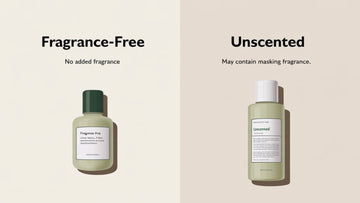Ever wondered why some skincare products work wonders for others but leave your skin irritated or greasy? The answer lies in understanding your skin type. Knowing your skin type is the foundation of building an effective skincare routine that works for you. Without identifying it, you may end up using products that are either too harsh or not effective enough, leading to breakouts, dryness, or irritation.
In this guide, we’ll take you through how to determine your skin type, the different types of skin, and how to avoid common mistakes people make when building their skincare routines.
Why Do You Need to Know Your Skin Type?
Your skin type influences how your skin reacts to different products, environments, and treatments. If you don’t know whether you have oily, dry, sensitive, or combination skin, you may choose the wrong products — resulting in clogged pores, excess oil, dryness, or even allergic reactions.
Key reasons to know your skin type:
- Choose the right products: Not all skincare is one-size-fits-all.
- Avoid irritation and breakouts: Using inappropriate products can harm your skin barrier.
- Target skin concerns effectively: Whether you are dealing with acne, ageing, or sensitivity, knowing your skin type helps address these issues properly.
- Build a personalised skincare routine: Tailor your skincare to meet your unique needs.
What Are the Types of Skin?
Skin types are usually classified into five basic categories. Each skin type has its characteristics, and knowing yours helps you care for it effectively.
1. Normal Skin
Balanced skin — not too oily, not too dry. It has minimal imperfections, no severe sensitivity, and barely visible pores.
2. Oily Skin
Shiny appearance, especially on the T-zone (forehead, nose, chin). Prone to enlarged pores, blackheads, and acne.
3. Dry Skin
Feels tight, flaky, or rough. Prone to red patches and irritation. Lacks natural moisture and may feel itchy.
4. Combination Skin
A mix of oily and dry areas. Typically, the T-zone is oily while the cheeks are dry or normal.
5. Sensitive Skin
Prone to redness, burning, itching, and irritation. Reacts easily to products, weather changes, and fragrances.
How to Determine Your Skin Type
Method 1: The Bare-Faced Test
- Cleanse your face with a gentle cleanser and pat dry.
- Leave your skin bare — no products, moisturisers, or serums.
- Wait for about 1 hour and observe how your skin feels and looks.
- Oily Skin: Shiny appearance, especially on the T-zone.
- Dry Skin: Feels tight or flaky.
- Combination Skin: Oily in some areas (T-zone), dry/normal in others.
- Normal Skin: Feels comfortable, neither oily nor dry.
- Sensitive Skin: May feel itchy, irritated, or show redness.
Method 2: The Blotting Sheet Test
- After washing your face and waiting an hour, gently press blotting paper on different areas.
- Hold the sheet up to light to see how much oil is visible.
- Lots of oil all over: Oily skin.
- Little to no oil: Dry skin.
- Oil in T-zone only: Combination skin.
- Balanced minimal oil: Normal skin.
Skincare Routine for Each Type of Skin
Normal Skin
- Cleanser: Mild, gentle cleanser.
- Moisturiser: Lightweight, hydrating.
- Sunscreen: Broad-spectrum SPF 30, 50+.
- Extras: Occasional exfoliation and serum as needed.
Oily Skin
- Cleanser: Foaming or gel-based to control excess oil.
- Moisturiser: Oil-free, non-comedogenic.
- Sunscreen: Matte finish, oil-control SPF.
- Extras: Salicylic acid for breakouts, clay masks.
Dry Skin
- Cleanser: Creamy, hydrating cleanser.
- Moisturiser: Rich and nourishing with ceramides/hyaluronic acid.
- Sunscreen: Moisturising SPF 30, 50+.
- Extras: Hydrating serums, avoid over-exfoliation.
Combination Skin
- Cleanser: Gentle, balancing cleanser.
- Moisturiser: Lightweight for oily zones, richer for dry areas.
- Sunscreen: Oil-free, lightweight SPF.
- Extras: Targeted treatments for specific zones
Sensitive Skin
- Cleanser: Fragrance-free, gentle cleanser.
- Moisturiser: Hypoallergenic, soothing.
- Sunscreen: Mineral-based SPF (zinc oxide, titanium dioxide).
- Extras: Minimal ingredients, avoid harsh exfoliants.
Common Mistakes to Avoid While Following Your Skincare Routine
- Using products not meant for your skin type: This can cause breakouts, irritation, or dryness.
- Skipping sunscreen: Regardless of your skin type, sunscreen is non-negotiable.
- Over-exfoliating: Leads to damaged skin barrier, especially in dry or sensitive skin.
- Not moisturising oily skin: Oily skin still needs hydration.
- Trying too many products: Keep it simple to avoid overwhelming your skin.
FAQs
1) How can I identify my skin type?
You can determine your skin type using the bare-faced method or blotting sheet test as described above. Observing how your skin feels after cleansing is a simple and effective way to know.
2) What's the most common skin type?
Combination skin is considered the most common, where people experience oily zones (usually the T-zone) and dryness in other areas.
3) What does oily skin feel like?
Oily skin often feels greasy and shiny, especially a few hours after cleansing. You may notice enlarged pores and frequent breakouts.
4) What does dry skin feel like?
Dry skin feels tight, rough, or flaky, especially after washing. It may look dull and can become itchy or irritated in extreme cases.
5) What does sensitive skin feel like?
Sensitive skin often burns, stings, or turns red when using new products or when exposed to environmental triggers. It requires gentle, calming products.
How Do I Know What Suits My Skin?
Choosing what suits your skin comes down to understanding its needs and reactions. Here are a few tips:
- Know your skin type first — this determines what ingredients and textures you should seek or avoid.
- Do a patch test — always try a new product on a small area of your skin to see how it reacts.
- Look for targeted solutions — for acne, go for salicylic acid; for dryness, choose hyaluronic acid or ceramides.
- Avoid products with harsh ingredients like alcohol, strong fragrances, and unnecessary chemicals if you have sensitive skin.
- Adjust with seasons — for example, opt for lightweight products in summer and richer creams in winter.
If you notice irritation, breakouts, or discomfort, the product may not be suitable for you — listen to your skin!
Conclusion
Understanding your skin type is the first and most essential step in building a skincare routine that truly works for you. Whether you have oily, dry, combination, sensitive, or normal skin, tailoring your products and care to match its needs will lead to healthier, glowing skin.
If you’re looking for dermatologically tested, skin-friendly products, Club Derma offers a range of solutions designed to nourish and protect your skin. We believe that skincare should be simple, effective, and suited to individual skin types — with science-backed formulations you can trust.






